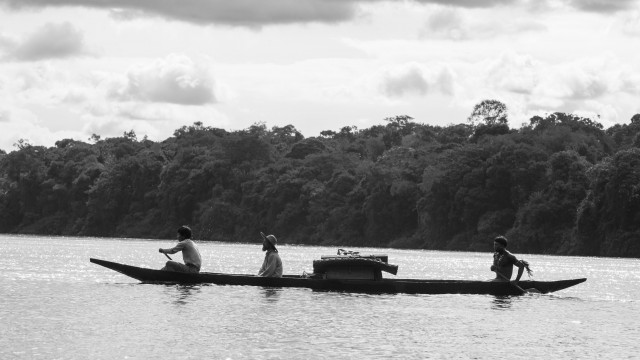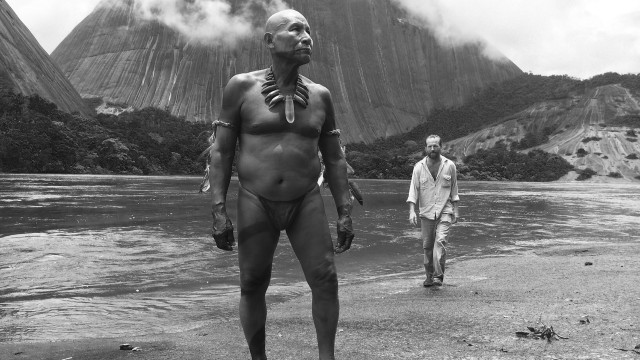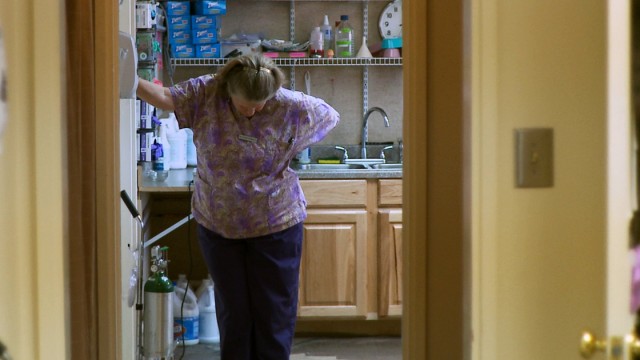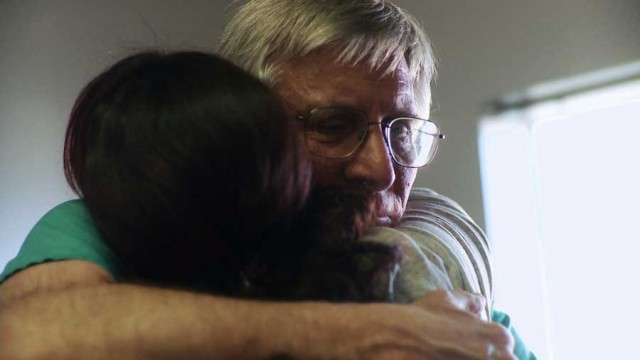AFTER TILLER (Martha Shane & Lana Wilson, 2013)
BAMcinématek, BAM Rose Cinemas
30 Lafayette Ave. between Ashland Pl. & St. Felix St.
Monday, February 19, $15, 7:00
Series runs February 19-22
718-636-4100
www.bam.org
www.aftertillermovie.com
 BAMcinématek celebrates the tenth anniversary of Oscilloscope Laboratories, the independent studio founded by Beastie Boy Adam Yauch in 2008, with five days of films that are representative of its dedication to quality and diversity, screening February 19-22. The series begins on February 19 at 7:00 with After Tiller, in which directors and producers Martha Shane and Lana Wilson manage to humanize one of the most contentious, controversial, and complicated issues of our age: late abortion. In May 2009, Dr. George Tiller, who specialized in third-trimester abortions, was assassinated in front of his clinic in Wichita, Kansas. That left only four doctors in the United States who performed late abortions, each of whom had either trained or worked with Dr. Tiller. “It was absolutely no question in any of our minds that we were going to keep on doing his work,” one of those four doctors, Susan Robinson, says in the film. As After Tiller begins, Dr. Robinson works with Dr. Shelley Sella at Southwestern Women’s Options in Albuquerque, New Mexico, Dr. LeRoy Carhart is a former U.S. Air Force colonel who operates the Abortion & Contraception Clinic of Nebraska, and Dr. Warren Hern is director of the Boulder Abortion Clinic in Colorado. Shane and Wilson follow these four dedicated doctors who continue doing their work despite the personal danger associated with their profession, including harassment, murder, assault, and bombings. “When I walk out the door, I expect to be assassinated,” Dr. Hern says. The filmmakers show the doctors in their offices, meeting with women who are requesting late abortions for various reasons; Shane and Wilson also follow the abortion providers into their homes as they go on with their daily lives, offering an intimate portrait of these men and women who are so often called monsters but are firm in their belief that what they are doing is important and absolutely necessary, performing their jobs with care and understanding. However, Dr. Hern wonders if he should stop providing late abortions and just settle down peacefully with his new wife and adopted son, while Dr. Carhart and his wife opt to move out of Nebraska after a law change and meet resistance as they try to move their clinic to Maryland or Virginia.
BAMcinématek celebrates the tenth anniversary of Oscilloscope Laboratories, the independent studio founded by Beastie Boy Adam Yauch in 2008, with five days of films that are representative of its dedication to quality and diversity, screening February 19-22. The series begins on February 19 at 7:00 with After Tiller, in which directors and producers Martha Shane and Lana Wilson manage to humanize one of the most contentious, controversial, and complicated issues of our age: late abortion. In May 2009, Dr. George Tiller, who specialized in third-trimester abortions, was assassinated in front of his clinic in Wichita, Kansas. That left only four doctors in the United States who performed late abortions, each of whom had either trained or worked with Dr. Tiller. “It was absolutely no question in any of our minds that we were going to keep on doing his work,” one of those four doctors, Susan Robinson, says in the film. As After Tiller begins, Dr. Robinson works with Dr. Shelley Sella at Southwestern Women’s Options in Albuquerque, New Mexico, Dr. LeRoy Carhart is a former U.S. Air Force colonel who operates the Abortion & Contraception Clinic of Nebraska, and Dr. Warren Hern is director of the Boulder Abortion Clinic in Colorado. Shane and Wilson follow these four dedicated doctors who continue doing their work despite the personal danger associated with their profession, including harassment, murder, assault, and bombings. “When I walk out the door, I expect to be assassinated,” Dr. Hern says. The filmmakers show the doctors in their offices, meeting with women who are requesting late abortions for various reasons; Shane and Wilson also follow the abortion providers into their homes as they go on with their daily lives, offering an intimate portrait of these men and women who are so often called monsters but are firm in their belief that what they are doing is important and absolutely necessary, performing their jobs with care and understanding. However, Dr. Hern wonders if he should stop providing late abortions and just settle down peacefully with his new wife and adopted son, while Dr. Carhart and his wife opt to move out of Nebraska after a law change and meet resistance as they try to move their clinic to Maryland or Virginia.
The film also reveals that deciding to perform a late abortion is often an extremely difficult choice for the doctors as well as the patients and not something the providers do automatically when a woman comes to them. One of the most compelling scenes occurs when Drs. Sella and Robinson have a heart-wrenching disagreement over whether to proceed with a late abortion for a young woman, evaluating whether her reason is valid enough and lamenting that the ability of the woman to tell her story could affect the final decision. It’s a pivotal moment that also brings into focus the concerns of the American people; while less than one percent of the abortions performed in the country occur in the third trimester, the procedure is often the centerpiece of the antiabortion movement, but even pro-choice supporters will find themselves questioning the efficacy of all late abortions. The women come to the doctors for many reasons, ranging from the health of the child to economic situations to admitting that they either didn’t know or refused to accept that they were pregnant until it was too late. “It’s guilt no matter which way you go,” one desperate patient, whose child would be born with severe disabilities and would likely die within a year, tells Dr. Sella. “Guilt if you go ahead and do what we’re doing, or bring him into this world and then he doesn’t have any quality of life.” Although Shane and Wilson include footage of protestors, news reports, and congressional hearings, After Tiller is a powerful, deeply emotional documentary about the doctors and patients who must make impossible choices and live with their decisions for the rest of their lives. The BAM screening of the film — which raises fascinating, difficult questions for which there are no easy answers — will be followed by a panel discussion with Lady Parts Justice League founder Lizz Winstead, Planned Parenthood of New York City general counsel Meg Barnette, and executive producer Diane Max, moderated by Obvious Child cowriter and producer Elisabeth Holm. “Oscilloscope at Ten” continues through February 22 with Andrew Dosunmu’s Mother of George, Ciro Guerra’s Embrace of the Serpent, Diego Echeverria’s Los Sures, and a double feature of Yauch’s Awesome; I Fuckin’ Shot That! and Fight for Your Right Revisited.

Embrace of the Serpent takes viewers on an extraordinary journey into the heart of darkness and beyond
EMBRACE OF THE SERPENT (EL ABRAZO DE LA SERPIENTE) (Ciro Guerra, 2015)
Wednesday, February 21, $15, 9:00
www.bam.org
embraceoftheserpent.oscilloscope.net
 Colombian writer-director Ciro Guerra takes viewers on a spectacular journey through time and space and deep into the heart of darkness in the extraordinary Embrace of the Serpent. Guerra’s Oscar-nominated film, the first to be shot in the Colombian Amazon in thirty years, opens with a 1909 quote from explorer Theodor Koch-Grünberg: “It is not possible for me to know if the infinite jungle has started on me the process that has taken many others to complete and irremediable insanity.” Inspired by the real-life journals of Koch-Grünberg and botanist and explorer Richard Evans Schultes, Guerra poetically shifts back and forth between two similar trips down the Vaupés River, both led by the same Amazonian shaman, each time guiding a white scientist on a perilous expedition in a long, narrow canoe. Shortly after the turn of the twentieth century, ailing white ethnologist Theo (Jan Bijvoet) and his native aid, Manduca (Yauenkü Migue), seek the help of Karamakate (Nilbio Torres), a shaman wholly suspicious of whites and who believes he is the last of his tribe. However, Theo claims he knows where remnants of Karamakate’s people live and will show him in return for helping him find the magical and mysterious hallucinogenic Yakruna plant that Theo thinks can cure his illness. Forty years later, white botanist Evan (Brionne Davis) enlists Karamakate (Antonio Bolívar Salvador) to locate what is thought to be the last surviving Yakruna plant, which he hopes will finally allow him to dream in order to heal his soul. Evoking such films as Werner Herzog’s Fitzcarraldo and Aguirre, the Wrath of God and Francis Ford Coppola’s Apocalypse Now, Embrace of the Serpent makes the rainforest itself a character, shot in glorious black-and-white by David Gallego (Cecilia, Violencia) in a sparkling palette reminiscent of the work of Brazilian photographer Sebastião Salgado. As the parallel stories continue, the men encounter similar locations that have changed dramatically over time, largely as a result of rubber barons descending on the forest and white missionaries bringing Western religion to the natives. It’s difficult to watch without being assailed by imperialist concepts of the “noble savage,” mainly because the Amazon — and our Western minds — have been so profoundly affected by those ideas. “Before he can become a warrior, a man has to leave everything behind and go into the jungle, guided only by his dreams,” the older Karamakate says. “In that journey he has to discover, completely alone, who he really is.”
Colombian writer-director Ciro Guerra takes viewers on a spectacular journey through time and space and deep into the heart of darkness in the extraordinary Embrace of the Serpent. Guerra’s Oscar-nominated film, the first to be shot in the Colombian Amazon in thirty years, opens with a 1909 quote from explorer Theodor Koch-Grünberg: “It is not possible for me to know if the infinite jungle has started on me the process that has taken many others to complete and irremediable insanity.” Inspired by the real-life journals of Koch-Grünberg and botanist and explorer Richard Evans Schultes, Guerra poetically shifts back and forth between two similar trips down the Vaupés River, both led by the same Amazonian shaman, each time guiding a white scientist on a perilous expedition in a long, narrow canoe. Shortly after the turn of the twentieth century, ailing white ethnologist Theo (Jan Bijvoet) and his native aid, Manduca (Yauenkü Migue), seek the help of Karamakate (Nilbio Torres), a shaman wholly suspicious of whites and who believes he is the last of his tribe. However, Theo claims he knows where remnants of Karamakate’s people live and will show him in return for helping him find the magical and mysterious hallucinogenic Yakruna plant that Theo thinks can cure his illness. Forty years later, white botanist Evan (Brionne Davis) enlists Karamakate (Antonio Bolívar Salvador) to locate what is thought to be the last surviving Yakruna plant, which he hopes will finally allow him to dream in order to heal his soul. Evoking such films as Werner Herzog’s Fitzcarraldo and Aguirre, the Wrath of God and Francis Ford Coppola’s Apocalypse Now, Embrace of the Serpent makes the rainforest itself a character, shot in glorious black-and-white by David Gallego (Cecilia, Violencia) in a sparkling palette reminiscent of the work of Brazilian photographer Sebastião Salgado. As the parallel stories continue, the men encounter similar locations that have changed dramatically over time, largely as a result of rubber barons descending on the forest and white missionaries bringing Western religion to the natives. It’s difficult to watch without being assailed by imperialist concepts of the “noble savage,” mainly because the Amazon — and our Western minds — have been so profoundly affected by those ideas. “Before he can become a warrior, a man has to leave everything behind and go into the jungle, guided only by his dreams,” the older Karamakate says. “In that journey he has to discover, completely alone, who he really is.”

Guide Karamakate (Antonio Bolívar Salvador) and botanist Evan (Brionne Davis) explore dreams in Ciro Guerra’s Embrace of the Serpent
Winner of the Directors’ Fortnight Art Cinema Award at the Cannes Film Festival and nominated for a Best Foreign Language Film Academy Award, Embrace of the Serpent is an unforgettable spiritual quest into the ravages of colonialism, the evils of materialism, the end of indigenous cultures, and what should be a sacred relationship between humanity and nature. Written by Guerra (2004’s Wandering Shadows, 2009’s The Wind Journeys) and Jacques Toulemonde (Anna), it is told from the point of view of the indigenous people of the Amazon, whom Guerra worked closely with in the making of the film, assuring them of his intentions to not exploit them the way so many others have. Aside from the Belgian Bijvoet and the Texan Davis, the rest of the cast is made up of members of tribes that live along the Vaupés. Guerra actually brought along a shaman known as a payé to perform ritual ceremonies to ensure the safety of the cast and crew and to protect the jungle itself. “What Ciro is doing with this film is an homage to the memory of our elders, in the time before: the way the white men treated the natives, the rubber exploitation,” Torres, in his first movie, says about the film. “I’ve asked the elders how it was and it is as seen in the film; that’s why we decided to support it. For the elders and myself it is a memory of the ancestors and their knowledge.” Salvador, who previously had bad experiences with filmmakers, notes, “It is a film that shows the Amazon, the lungs of the world, the greater purifying filter, and the most valuable of indigenous cultures. That is its greatest achievement.” Embrace of the Serpent is a great achievement indeed, an honest, humanistic, maddening journey that takes you places you’ve never been. Embrace of the Serpent is screening February 21 in the BAMcinématek series “Oscilloscope at Ten.”

